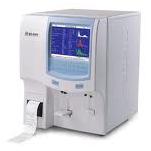Cell counters
 Automated cell counters sample the blood, and quantify, classify, and describe cell populations using both electrical and optical techniques. Electrical analysis involves passing a dilute solution of the blood through an aperture across which an electrical current is flowing. A lytic reagent is added to the blood solution to selectively lyse the red cells (RBCs), leaving only white cells (WBCs), and platelets intact. The platelet count is easily separated from the WBC count by the smaller impedance spikes they produce in the detector due to their lower cell volumes.
Automated cell counters sample the blood, and quantify, classify, and describe cell populations using both electrical and optical techniques. Electrical analysis involves passing a dilute solution of the blood through an aperture across which an electrical current is flowing. A lytic reagent is added to the blood solution to selectively lyse the red cells (RBCs), leaving only white cells (WBCs), and platelets intact. The platelet count is easily separated from the WBC count by the smaller impedance spikes they produce in the detector due to their lower cell volumes.
Optical detection may be utilised to gain a differential count of the populations of white cell types. A dilute suspension of cells is passed through a flow cell, which passes cells one at a time through a capillary tube past a laser beam. The reflectance, transmission and scattering of light from each cell is analysed by sophisticated software giving a numerical representation of the likely overall distribution of cell populations.
Reticulocyte counts can now be performed by many analysers, giving an alternative to time-consuming manual counts. Many automated reticulocyte counts, like their manual counterparts, employ the use of a supravital dye such as new methylene blue to stain the red cells containing reticulin prior to counting.
For more info product get this! : Hematology Analyzer from amazon.comm 

Autoread Plus Hematology System

ABX Diagnostics HORIBA Pentra 400 Clinical Chemistry Analyzer
from: MedexSupply

Autoread Plus Hematology System
ABX Diagnostics HORIBA Pentra 400 Clinical Chemistry Analyzer
from: MedexSupply
